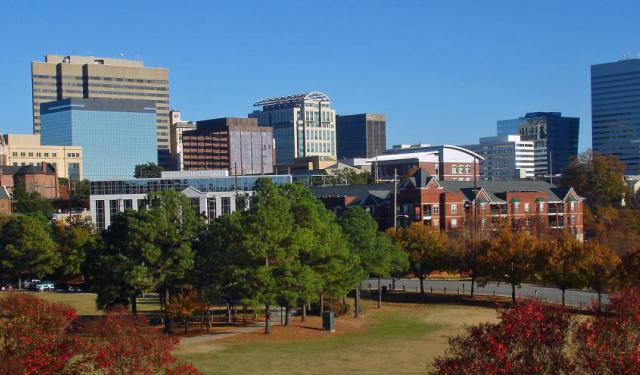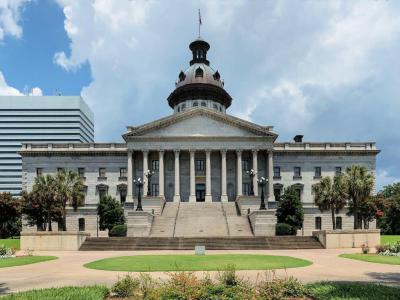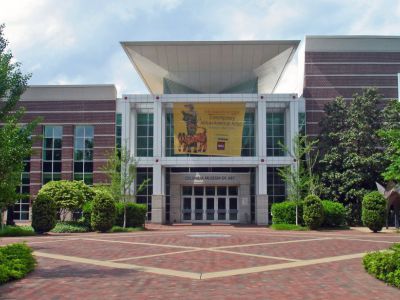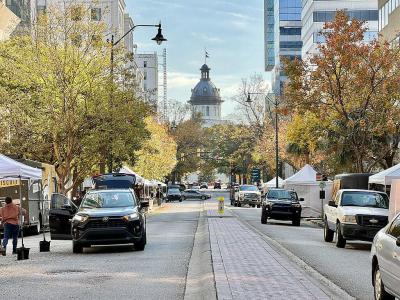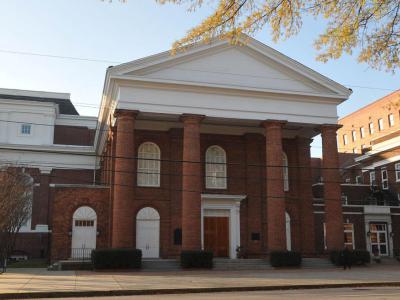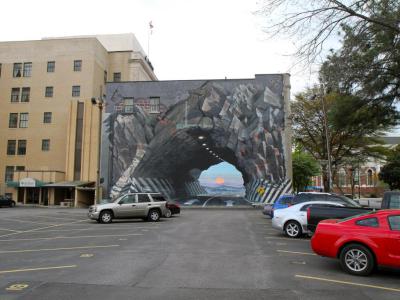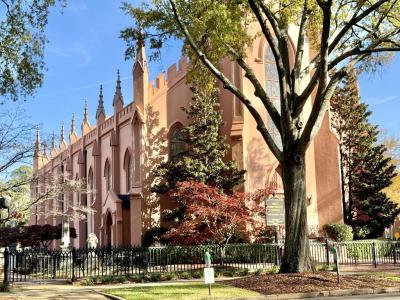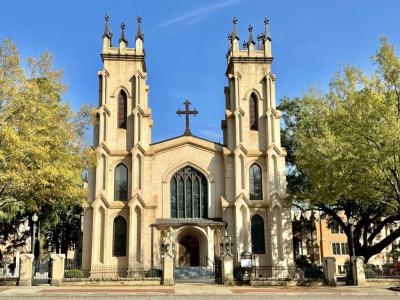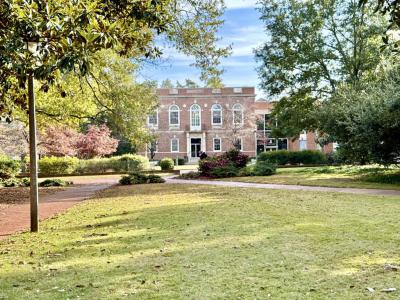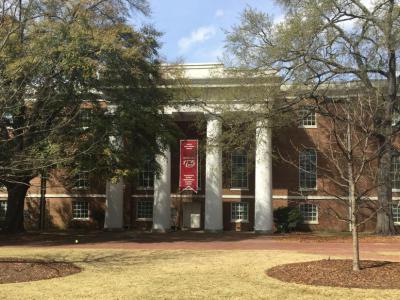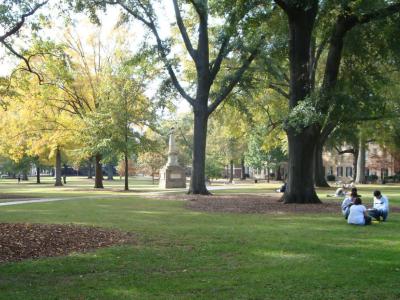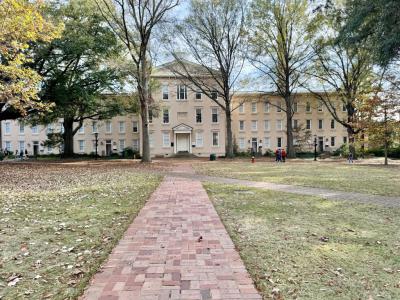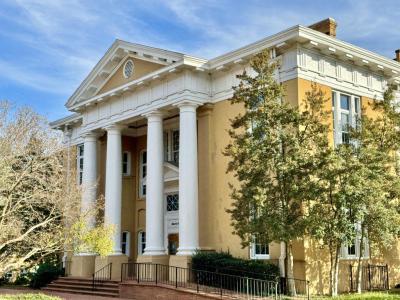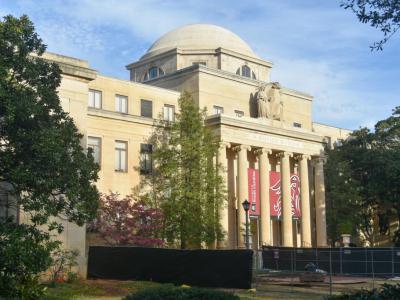Columbia Introduction Walking Tour (Self Guided), Columbia
Columbia, the capital and largest city of South Carolina is a treasure trove of historical significance, cultural wealth, and Southern charm. The city's history is marked by its role in the American Civil War. This historical backdrop sets the stage for Columbia’s many landmarks and educational institutions that speak volumes of its resilience and cultural evolution.
In May 1540, a Spanish expedition exploring the area now known as Columbia marked its first documented European encounter. Subsequent European settlers established a fort and trading post along the Congaree River, building a ferry in 1754 and harnessing the rapids for mills.
In 1786, after the American Revolutionary War, Columbia was officially designated as South Carolina's capital due to its central location – to encourage growth away from the coastal areas, historically susceptible to pirate attacks.
The city's name – after Christopher Columbus – was chosen by a narrow senate vote over "Washington." Columbia was one of the first planned cities in the United States, with its early development spurred by projects like the Santee Canal.
Columbia quickly grew into an educational and economic hub with the founding of the University of South Carolina in 1801, aiming to unify the state post-war. The city's growth was further fueled by cotton and railroads. By the mid-19th century, Columbia had a significant slave population and during the Civil War served as a crucial Confederate resource center. It was largely destroyed by fire in 1865 during General Sherman’s infamous march and capture of the city.
The Reconstruction era saw Columbia rebuild and expand culturally and politically, with significant construction in the early 20th century enhancing its status as a commercial hub. The late 20th century brought urban development and historic preservation, transforming Columbia into a modern metropolitan area. Nowadays, Main Street, first paved in 1908, comes bustling each month during the "First Thursday on Main" event, when businesses stay open late, and the street fills with music and food vendors.
One of the city's most iconic landmarks is the South Carolina State House. This majestic building, with its towering dome and grand architecture, stands as a testament to the city's historical and political significance.
For those intrigued by the blend of historical depth and modern vibrancy, Columbia offers an enriching journey through time and culture. Whether you’re exploring educational sites, enjoying local art, or delving into historical archives, Columbia welcomes all. Come and discover the heart of South Carolina-experience its charm, delve into its history, and create your own memories in a city that truly embodies the spirit of the South.
In May 1540, a Spanish expedition exploring the area now known as Columbia marked its first documented European encounter. Subsequent European settlers established a fort and trading post along the Congaree River, building a ferry in 1754 and harnessing the rapids for mills.
In 1786, after the American Revolutionary War, Columbia was officially designated as South Carolina's capital due to its central location – to encourage growth away from the coastal areas, historically susceptible to pirate attacks.
The city's name – after Christopher Columbus – was chosen by a narrow senate vote over "Washington." Columbia was one of the first planned cities in the United States, with its early development spurred by projects like the Santee Canal.
Columbia quickly grew into an educational and economic hub with the founding of the University of South Carolina in 1801, aiming to unify the state post-war. The city's growth was further fueled by cotton and railroads. By the mid-19th century, Columbia had a significant slave population and during the Civil War served as a crucial Confederate resource center. It was largely destroyed by fire in 1865 during General Sherman’s infamous march and capture of the city.
The Reconstruction era saw Columbia rebuild and expand culturally and politically, with significant construction in the early 20th century enhancing its status as a commercial hub. The late 20th century brought urban development and historic preservation, transforming Columbia into a modern metropolitan area. Nowadays, Main Street, first paved in 1908, comes bustling each month during the "First Thursday on Main" event, when businesses stay open late, and the street fills with music and food vendors.
One of the city's most iconic landmarks is the South Carolina State House. This majestic building, with its towering dome and grand architecture, stands as a testament to the city's historical and political significance.
For those intrigued by the blend of historical depth and modern vibrancy, Columbia offers an enriching journey through time and culture. Whether you’re exploring educational sites, enjoying local art, or delving into historical archives, Columbia welcomes all. Come and discover the heart of South Carolina-experience its charm, delve into its history, and create your own memories in a city that truly embodies the spirit of the South.
How it works: Download the app "GPSmyCity: Walks in 1K+ Cities" from Apple App Store or Google Play Store to your mobile phone or tablet. The app turns your mobile device into a personal tour guide and its built-in GPS navigation functions guide you from one tour stop to next. The app works offline, so no data plan is needed when traveling abroad.
Columbia Introduction Walking Tour Map
Guide Name: Columbia Introduction Walking Tour
Guide Location: USA » Columbia (See other walking tours in Columbia)
Guide Type: Self-guided Walking Tour (Sightseeing)
# of Attractions: 13
Tour Duration: 2 Hour(s)
Travel Distance: 3.6 Km or 2.2 Miles
Author: DanaOffice
Sight(s) Featured in This Guide:
Guide Location: USA » Columbia (See other walking tours in Columbia)
Guide Type: Self-guided Walking Tour (Sightseeing)
# of Attractions: 13
Tour Duration: 2 Hour(s)
Travel Distance: 3.6 Km or 2.2 Miles
Author: DanaOffice
Sight(s) Featured in This Guide:
- South Carolina State House
- Columbia Museum of Art
- Main Street
- First Baptist Church
- Tunnel Mural
- First Presbyterian Church
- Trinity Episcopal Cathedral
- University of South Carolina
- South Caroliniana Library
- The Horseshoe
- Rutledge College
- Davis College
- McKissick Museum
1) South Carolina State House (must see)
The South Carolina State House serves as the central hub for the state government. This historic building houses the South Carolina General Assembly, the offices of the Governor, and the Lieutenant Governor. Until 1971, it was also the home of the state's Supreme Court, further emphasizing its significance in South Carolina's political and judicial history.
Designed in the Greek Revival style, the State House stands as an architectural landmark, measuring approximately 180 feet in height, 300 feet in length, and 100 feet in width. With a total area of 130,673 square feet, the building's grandiose design and significant size reflect its importance. The initial design by architect P. H. Hammarskold faced substantial challenges; construction began in 1851 but was soon halted due to fraud and dereliction of duty on Hammarskold's part. Defective materials and poor workmanship led to the building's partial dismantlement.
John Niernsee took over the project in 1855, bringing a new vision and dedication to the State House's construction. However, progress was significantly hindered during the Civil War and came to a complete halt in 1865 when General Sherman's Union Army entered Columbia on February 17. Despite the widespread destruction caused by the Union troops, who set several public buildings ablaze, the State House was spared from the flames, allowing its construction to eventually resume.
The South Carolina State House stands today not only as a functioning government building but also as a symbol of resilience and historical continuity. Its survival through turbulent times and its prominent architectural style make it a notable landmark in Columbia, reflecting both the past struggles and the ongoing governance of South Carolina.
Designed in the Greek Revival style, the State House stands as an architectural landmark, measuring approximately 180 feet in height, 300 feet in length, and 100 feet in width. With a total area of 130,673 square feet, the building's grandiose design and significant size reflect its importance. The initial design by architect P. H. Hammarskold faced substantial challenges; construction began in 1851 but was soon halted due to fraud and dereliction of duty on Hammarskold's part. Defective materials and poor workmanship led to the building's partial dismantlement.
John Niernsee took over the project in 1855, bringing a new vision and dedication to the State House's construction. However, progress was significantly hindered during the Civil War and came to a complete halt in 1865 when General Sherman's Union Army entered Columbia on February 17. Despite the widespread destruction caused by the Union troops, who set several public buildings ablaze, the State House was spared from the flames, allowing its construction to eventually resume.
The South Carolina State House stands today not only as a functioning government building but also as a symbol of resilience and historical continuity. Its survival through turbulent times and its prominent architectural style make it a notable landmark in Columbia, reflecting both the past struggles and the ongoing governance of South Carolina.
2) Columbia Museum of Art
The Columbia Museum of Art stands as a vibrant cultural institution showcasing a diverse collection of European and American fine and decorative art spanning multiple centuries. Housed within a transformed urban department store, the museum boasts 25 light-filled galleries that provide an immersive experience for visitors.
A highlight of the museum's collection is its Renaissance and Baroque collection, generously gifted by the Samuel Kress Foundation. This collection features an array of Old Master paintings, many of which were originally commissioned by churches in Italy during the 15th and 16th centuries. Upstairs galleries showcase Nativity scenes, Madonna and Child paintings, and scenes from the Old and New Testaments, offering insight into religious iconography and artistic expression of the era. Notably, the museum also boasts a rare and monumental Nativity fresco transferred to canvas by the esteemed Florentine Renaissance artist Sandro Botticelli.
In addition to its Renaissance and Baroque treasures, the Columbia Museum of Art houses notable works from other periods and regions. Claude Monet's serene landscape painting, The Seine at Giverny, graces the museum's walls, alongside exquisite art glass by Louis Comfort Tiffany. The museum's decorative arts collection comprises around 3,000 objects, primarily dating from the 17th to the 20th centuries. From silverware and Chinese export porcelain to contemporary art glass and American furniture, the collection offers a comprehensive view of artistic craftsmanship and design across cultures and epochs. Additionally, the Turner Collection includes a selection of Asian objects dating back to the T'ang Dynasty, further enriching the museum's diverse offerings.
A highlight of the museum's collection is its Renaissance and Baroque collection, generously gifted by the Samuel Kress Foundation. This collection features an array of Old Master paintings, many of which were originally commissioned by churches in Italy during the 15th and 16th centuries. Upstairs galleries showcase Nativity scenes, Madonna and Child paintings, and scenes from the Old and New Testaments, offering insight into religious iconography and artistic expression of the era. Notably, the museum also boasts a rare and monumental Nativity fresco transferred to canvas by the esteemed Florentine Renaissance artist Sandro Botticelli.
In addition to its Renaissance and Baroque treasures, the Columbia Museum of Art houses notable works from other periods and regions. Claude Monet's serene landscape painting, The Seine at Giverny, graces the museum's walls, alongside exquisite art glass by Louis Comfort Tiffany. The museum's decorative arts collection comprises around 3,000 objects, primarily dating from the 17th to the 20th centuries. From silverware and Chinese export porcelain to contemporary art glass and American furniture, the collection offers a comprehensive view of artistic craftsmanship and design across cultures and epochs. Additionally, the Turner Collection includes a selection of Asian objects dating back to the T'ang Dynasty, further enriching the museum's diverse offerings.
3) Main Street
Main Street holds a special place in the heart of the capital city. This vibrant district is a bustling hub of activity, offering a diverse range of experiences that are hard to resist. With an array of over 50 dining options, catering to both elegant and casual tastes, and a multitude of shops and charming boutiques, Main Street provides a unique and unforgettable downtown encounter.
Situated at the core of downtown Columbia, the recently revitalized Main Street district boasts an assortment of shops like the vintage-inspired Mast General Store, as well as a variety of restaurants, government buildings, and historic sites. A visit to this urban area is undoubtedly one of the most enjoyable things to do in Columbia.
Throughout the year, Main Street hosts a plethora of events and festivals, such as First Thursdays on Main and the Soda City Market. Surrounding this lively district are some of the city's finest cultural attractions, including the architecturally impressive main branch of the Richland Library, the Columbia Museum of Art, and the South Carolina State House. Visitors can even take free tours of the government offices and view historic artworks, with the option for families to engage in an on-site scavenger hunt for added enjoyment and education.
Situated at the core of downtown Columbia, the recently revitalized Main Street district boasts an assortment of shops like the vintage-inspired Mast General Store, as well as a variety of restaurants, government buildings, and historic sites. A visit to this urban area is undoubtedly one of the most enjoyable things to do in Columbia.
Throughout the year, Main Street hosts a plethora of events and festivals, such as First Thursdays on Main and the Soda City Market. Surrounding this lively district are some of the city's finest cultural attractions, including the architecturally impressive main branch of the Richland Library, the Columbia Museum of Art, and the South Carolina State House. Visitors can even take free tours of the government offices and view historic artworks, with the option for families to engage in an on-site scavenger hunt for added enjoyment and education.
4) First Baptist Church
The First Baptist Church is a historic Greek Revival building constructed in 1856. The church, first organized in 1809, originally built its first sanctuary on Sumter Street in 1811. The current edifice, funded by James P. Boyce, a former president of the Southern Baptist Theological Seminary, was erected by an unknown architect and stands as a significant architectural and historical landmark in Columbia.
A pivotal moment in American history took place within the walls of the First Baptist Church. On December 17, 1860, the church hosted a convention that would lead to South Carolina's secession from the United States, an event that precipitated the American Civil War. Chosen for this momentous occasion due to its status as the largest meeting place in Columbia at the time, the church became the site where 159 delegates, under the chairmanship of D. F. Jamison, voted unanimously in favor of secession following the election of Abraham Lincoln as President.
This decisive vote not only marked South Carolina's secession but also set a precedent for six other Southern states to follow suit before the outbreak of the Civil War at Fort Sumter. The convention's decision underscored the contentious debate over states' rights and secession, an issue that had never been definitively resolved in a court of law. The unanimous vote at the First Baptist Church highlighted the urgency and fervor with which these states pursued their secessionist ambitions.
A pivotal moment in American history took place within the walls of the First Baptist Church. On December 17, 1860, the church hosted a convention that would lead to South Carolina's secession from the United States, an event that precipitated the American Civil War. Chosen for this momentous occasion due to its status as the largest meeting place in Columbia at the time, the church became the site where 159 delegates, under the chairmanship of D. F. Jamison, voted unanimously in favor of secession following the election of Abraham Lincoln as President.
This decisive vote not only marked South Carolina's secession but also set a precedent for six other Southern states to follow suit before the outbreak of the Civil War at Fort Sumter. The convention's decision underscored the contentious debate over states' rights and secession, an issue that had never been definitively resolved in a court of law. The unanimous vote at the First Baptist Church highlighted the urgency and fervor with which these states pursued their secessionist ambitions.
5) Tunnel Mural
A Columbia icon since its creation, Tunnelvision-also known as the Tunnel Mural-is a monumental 50 x 75-foot trompe-l'œil painting that transforms an ordinary downtown wall into a surreal portal to another world. Created by local artist Blue Sky, the mural is designed to appear as a naturalistic tunnel, as if a craggy road is cutting straight through the wall and leading toward a distant moonlit landscape.
This illusion of depth is so striking that it has stopped pedestrians in their tracks-and occasionally made drivers double-take. Using the trompe-l'œil technique, which tricks the eye into perceiving a three-dimensional scene on a flat surface, Blue Sky achieved a level of realism that continues to impress decades after its original creation.
Inspired by a dream, Tunnelvision is part of Blue Sky’s legacy of large-scale public art in Columbia, which includes other head-turning works like Busted Plug Plaza and Neverbust Chain. The artist continues to touch up and enhance the mural over time, ensuring that its sense of mystery and realism doesn’t fade but grows even stronger.
Conveniently located in the same parking lot as Busted Plug, Tunnelvision offers a two-for-one dose of Columbia’s unique urban art. It’s a beloved photo spot, a curious local legend, and-if you're not careful-a very convincing invitation to take a detour into another dimension.
This illusion of depth is so striking that it has stopped pedestrians in their tracks-and occasionally made drivers double-take. Using the trompe-l'œil technique, which tricks the eye into perceiving a three-dimensional scene on a flat surface, Blue Sky achieved a level of realism that continues to impress decades after its original creation.
Inspired by a dream, Tunnelvision is part of Blue Sky’s legacy of large-scale public art in Columbia, which includes other head-turning works like Busted Plug Plaza and Neverbust Chain. The artist continues to touch up and enhance the mural over time, ensuring that its sense of mystery and realism doesn’t fade but grows even stronger.
Conveniently located in the same parking lot as Busted Plug, Tunnelvision offers a two-for-one dose of Columbia’s unique urban art. It’s a beloved photo spot, a curious local legend, and-if you're not careful-a very convincing invitation to take a detour into another dimension.
6) First Presbyterian Church
The origins of the First Presbyterian Church trace back to 1795, when its initial meetings were held, but it wasn't until 1813 that the congregation had its own building. That same year, the South Carolina Legislature officially incorporated the church as the "First Presbyterian Church of the Town of Columbia," marking its formal establishment.
Before the church had its own building, the site where it now stands was a shared cemetery with the local Episcopal congregation from 1794 to 1813. The legislature allocated this cemetery and other lands to both Episcopalians and Presbyterians, creating a shared space for both congregations. According to local legend, the First Presbyterian Church and the nearby Trinity Episcopal Cathedral determined their respective lots by drawing lots. The Presbyterians received the cemetery at the corner of Lady and Marion Streets, which became the location of their church.
The original 1813 building of the First Presbyterian Church still exists today, known as Jackson Hall. However, the growing congregation necessitated the construction of a larger building, and in 1854, a new English Gothic structure was completed. This new church, spared destruction during General Sherman's march to the sea during the Civil War, faced other challenges.
In 1875, a hurricane destroyed its original 180-foot spire, which was then rebuilt in 1888. Further damage occurred in a 1910 fire, leading to another reconstruction that increased the spire's height by eight feet. A significant remodeling in 1925 expanded the church's capacity from 800 to 1,250, lengthening the building by 40 feet and adding classrooms on the sides, a choir loft at the rear, and a rebuilt organ loft.
Before the church had its own building, the site where it now stands was a shared cemetery with the local Episcopal congregation from 1794 to 1813. The legislature allocated this cemetery and other lands to both Episcopalians and Presbyterians, creating a shared space for both congregations. According to local legend, the First Presbyterian Church and the nearby Trinity Episcopal Cathedral determined their respective lots by drawing lots. The Presbyterians received the cemetery at the corner of Lady and Marion Streets, which became the location of their church.
The original 1813 building of the First Presbyterian Church still exists today, known as Jackson Hall. However, the growing congregation necessitated the construction of a larger building, and in 1854, a new English Gothic structure was completed. This new church, spared destruction during General Sherman's march to the sea during the Civil War, faced other challenges.
In 1875, a hurricane destroyed its original 180-foot spire, which was then rebuilt in 1888. Further damage occurred in a 1910 fire, leading to another reconstruction that increased the spire's height by eight feet. A significant remodeling in 1925 expanded the church's capacity from 800 to 1,250, lengthening the building by 40 feet and adding classrooms on the sides, a choir loft at the rear, and a rebuilt organ loft.
7) Trinity Episcopal Cathedral
Trinity Episcopal Cathedral holds the distinction of being the first Episcopal church and the oldest surviving sanctuary in Columbia. This Gothic Revival church, modeled after the medieval York Minster in York, England, was officially listed on the National Register of Historic Places on February 24, 1971. Situated on the east side of Sumter Street, between Gervais and Senate Streets, it stands directly east of the South Carolina State House, making it a prominent landmark in the city's historic district.
The church was designed by Edward Brickell White, who employed a Gothic Revival style to create a structure reminiscent of York Minster. The cornerstone was laid on November 26, 1845, by the rector, Peter Shand. Although originally intended to have a cruciform design, only the nave and twin towers were constructed. These towers, each adorned with eight pinnacles topped with a fleur-de-lis, add to the church's medieval aesthetic. The brick structure was plastered with buff stucco, and both the towers and walls feature shouldered buttresses. The nave, distinguished by its clerestory-the only one in a Columbia church-is supported by exposed wooden beams. The church was consecrated by Bishop Gadsden on February 14, 1857.
Throughout its history, Trinity Episcopal Cathedral has been marked by the planting of live oak trees in its churchyard, symbolizing different milestones in the Parish’s history. The first tree, known as the Sire Oak, was planted in 1814 after the completion of the initial church building. The second tree was planted in 1900, celebrating the completion of the current structure, and the third tree was planted in 1925, marking the completion of the Parish House. These oaks, along with the wrought iron fence surrounding the churchyard, contribute to the historic and serene ambiance of the cathedral grounds.
The church was designed by Edward Brickell White, who employed a Gothic Revival style to create a structure reminiscent of York Minster. The cornerstone was laid on November 26, 1845, by the rector, Peter Shand. Although originally intended to have a cruciform design, only the nave and twin towers were constructed. These towers, each adorned with eight pinnacles topped with a fleur-de-lis, add to the church's medieval aesthetic. The brick structure was plastered with buff stucco, and both the towers and walls feature shouldered buttresses. The nave, distinguished by its clerestory-the only one in a Columbia church-is supported by exposed wooden beams. The church was consecrated by Bishop Gadsden on February 14, 1857.
Throughout its history, Trinity Episcopal Cathedral has been marked by the planting of live oak trees in its churchyard, symbolizing different milestones in the Parish’s history. The first tree, known as the Sire Oak, was planted in 1814 after the completion of the initial church building. The second tree was planted in 1900, celebrating the completion of the current structure, and the third tree was planted in 1925, marking the completion of the Parish House. These oaks, along with the wrought iron fence surrounding the churchyard, contribute to the historic and serene ambiance of the cathedral grounds.
8) University of South Carolina (must see)
The University of South Carolina (USC), also known simply as Carolina, is a prominent public, co-educational research university. Spanning over 359 acres in downtown Columbia, the campus is situated near the South Carolina State House. A defining feature of the university is the Horseshoe, a U-shaped quadrangle of eleven historic buildings that opens to Sumter Street. Originally the heart of the campus, the Horseshoe remains a central and iconic area. Throughout the 20th century, the university expanded significantly beyond the Horseshoe, developing a campus that now includes a student union, 24 residence halls, numerous academic buildings, and various cultural and athletic facilities.
Among the notable facilities on campus are the Longstreet Theatre, the Koger Center for the Arts, the Carolina Coliseum, the Colonial Life Arena, and Carolina Stadium. These venues support a range of activities from performing arts and sports to large-scale university events. The university also boasts specialized facilities for Olympic sports, reflecting its comprehensive support for student-athletes. USC's expansive campus and diverse infrastructure cater to the needs of its large student population and contribute to a vibrant campus life.
The University of South Carolina is recognized for its significant research contributions and is categorized by the Carnegie Foundation for the Advancement of Teaching as having "highest research activity." This designation places USC among the top research institutions in the nation, highlighting its extensive research programs and commitment to innovation and academic excellence. The university's research initiatives span various disciplines, fostering an environment where both faculty and students can engage in cutting-edge research and scholarly pursuits.
One of the highlights of the university's College of Art and Science is the McKissick Museum, which houses extensive collections related to natural sciences, history, and art. The museum features a wide array of materials, including mineral collections, 18th-century silver, gemstones, and other stones predominantly found in the southwestern United States. The McKissick Museum serves as an educational resource and cultural hub for the university community and the public, showcasing the rich and diverse history of the region's natural and cultural heritage.
Among the notable facilities on campus are the Longstreet Theatre, the Koger Center for the Arts, the Carolina Coliseum, the Colonial Life Arena, and Carolina Stadium. These venues support a range of activities from performing arts and sports to large-scale university events. The university also boasts specialized facilities for Olympic sports, reflecting its comprehensive support for student-athletes. USC's expansive campus and diverse infrastructure cater to the needs of its large student population and contribute to a vibrant campus life.
The University of South Carolina is recognized for its significant research contributions and is categorized by the Carnegie Foundation for the Advancement of Teaching as having "highest research activity." This designation places USC among the top research institutions in the nation, highlighting its extensive research programs and commitment to innovation and academic excellence. The university's research initiatives span various disciplines, fostering an environment where both faculty and students can engage in cutting-edge research and scholarly pursuits.
One of the highlights of the university's College of Art and Science is the McKissick Museum, which houses extensive collections related to natural sciences, history, and art. The museum features a wide array of materials, including mineral collections, 18th-century silver, gemstones, and other stones predominantly found in the southwestern United States. The McKissick Museum serves as an educational resource and cultural hub for the university community and the public, showcasing the rich and diverse history of the region's natural and cultural heritage.
9) South Caroliniana Library
The South Caroliniana Library, celebrated as the first separate college library building in the United States, occupies a prominent position at the northwest corner of the University of South Carolina's historic Horseshoe. Designed by renowned architect Robert Mills in 1840, the library is a distinguished example of Greek Revival architecture, characterized by its classical proportions and decorative elements. This historic structure symbolizes the university's long-standing commitment to academic excellence and the preservation of knowledge.
By 1927, the burgeoning library collection had outgrown the original structure, necessitating expansion. J. Carroll Johnson, a noted architect from Columbia, designed two fireproof wings to accommodate the growing volume of materials. This expansion ensured the library could continue to serve its essential role in supporting the university's academic programs. However, with the construction of a new library building in 1940-now known as McKissick Museum and the USC Visitors Center-the original South Caroliniana Library transitioned into a special collections library. This shift allowed it to house valuable manuscripts and archival materials documenting South Carolina's rich history.
In the 1970s, the South Caroliniana Library underwent significant interior and exterior renovations to modernize the facility and enhance its functionality. These updates included the introduction of air conditioning, which improved the preservation conditions for the library's precious collections and provided a more comfortable environment for researchers and visitors.
By 1927, the burgeoning library collection had outgrown the original structure, necessitating expansion. J. Carroll Johnson, a noted architect from Columbia, designed two fireproof wings to accommodate the growing volume of materials. This expansion ensured the library could continue to serve its essential role in supporting the university's academic programs. However, with the construction of a new library building in 1940-now known as McKissick Museum and the USC Visitors Center-the original South Caroliniana Library transitioned into a special collections library. This shift allowed it to house valuable manuscripts and archival materials documenting South Carolina's rich history.
In the 1970s, the South Caroliniana Library underwent significant interior and exterior renovations to modernize the facility and enhance its functionality. These updates included the introduction of air conditioning, which improved the preservation conditions for the library's precious collections and provided a more comfortable environment for researchers and visitors.
10) The Horseshoe
The Horseshoe, located at the heart of the University of South Carolina's main campus, is a historic district known for its picturesque and historically significant architecture. This area, formally recognized as the Old Campus District, was listed on the National Register of Historic Places on June 5, 1970.
The district is renowned for its collection of buildings that predominantly reflect the Federal style of architecture, popular in the early days of the United States. Among these architectural gems is the South Caroliniana Library, designed by Robert Mills. This library holds the distinction of being the first freestanding academic library in the United States, underscoring the historical importance of The Horseshoe within the realm of American higher education.
The Horseshoe has also served as a cultural and social hub for the university. A notable event in its more recent history was the filming of MTV Unplugged featuring Hootie & the Blowfish on April 19, 1996, just before the release of their second album, Fairweather Johnson. This event highlighted The Horseshoe's role not only as a center for academic and historical significance but also as a venue for contemporary cultural activities.
The district is renowned for its collection of buildings that predominantly reflect the Federal style of architecture, popular in the early days of the United States. Among these architectural gems is the South Caroliniana Library, designed by Robert Mills. This library holds the distinction of being the first freestanding academic library in the United States, underscoring the historical importance of The Horseshoe within the realm of American higher education.
The Horseshoe has also served as a cultural and social hub for the university. A notable event in its more recent history was the filming of MTV Unplugged featuring Hootie & the Blowfish on April 19, 1996, just before the release of their second album, Fairweather Johnson. This event highlighted The Horseshoe's role not only as a center for academic and historical significance but also as a venue for contemporary cultural activities.
11) Rutledge College
Rutledge College, originally known as South Building, holds the distinction of being the first building constructed for South Carolina College. Opening its doors in 1805, the building served multiple functions, housing a dormitory, lecture hall, chapel, and library, making it the central hub of academic and student life on campus. This multifunctional design reflected the educational needs and aspirations of the early 19th century, providing a comprehensive environment for learning and community engagement.
In 1855, a devastating fire severely damaged the chapel and the west wing of Rutledge College. The destruction necessitated extensive rebuilding efforts to restore the building to its former glory. Despite this setback, Rutledge College continued to play a pivotal role in the university's history. Notably, during the period of desegregation between 1873 and 1877, the building housed the State Normal School for Teachers. This program was instrumental in training African American teachers, marking a significant chapter in the university's commitment to education and social progress.
Today, Rutledge College serves as a residence hall for students, maintaining its historical significance while adapting to contemporary needs. The building's renovated chapel has been repurposed for rentals, offering a picturesque and historically rich venue for various events. This blend of modern utility and historical preservation ensures that Rutledge College remains a vibrant part of the University of South Carolina's campus life.
In 1855, a devastating fire severely damaged the chapel and the west wing of Rutledge College. The destruction necessitated extensive rebuilding efforts to restore the building to its former glory. Despite this setback, Rutledge College continued to play a pivotal role in the university's history. Notably, during the period of desegregation between 1873 and 1877, the building housed the State Normal School for Teachers. This program was instrumental in training African American teachers, marking a significant chapter in the university's commitment to education and social progress.
Today, Rutledge College serves as a residence hall for students, maintaining its historical significance while adapting to contemporary needs. The building's renovated chapel has been repurposed for rentals, offering a picturesque and historically rich venue for various events. This blend of modern utility and historical preservation ensures that Rutledge College remains a vibrant part of the University of South Carolina's campus life.
12) Davis College
Davis College, built in 1909, holds the distinction of being the University of South Carolina's first new building erected after the Civil War. This Classical Revival-style structure was designed by Charles C. Wilson specifically to house the Department of English.
Named in honor of Robert Means Davis, a distinguished alumnus and professor of history and political economy, the building reflects both historical significance and architectural elegance. Its stucco-clad exterior is adorned with two-story porticoes supported by Doric columns on the north and south facades, topped with pediments, hipped roofs, and an architrave featuring triglyphs.
The building's architectural details are meticulously crafted, showcasing six-over-six double-hung windows, doorways with transoms and decorative trim surrounds, and arched bays on the first floor. These elements contribute to the building's grandeur and classical aesthetic, making it a prominent feature on the university's historic campus. The interior and exterior designs embody the principles of Classical Revival architecture, emphasizing symmetry, proportion, and the use of classical orders.
Today, Davis College serves as the home for the School of Library and Information Science, continuing its legacy of academic excellence and scholarly pursuit. As a contributing structure in the Old Campus District, part of the University of South Carolina Historic District, it is listed on the National Register of Historic Places since 1970.
Named in honor of Robert Means Davis, a distinguished alumnus and professor of history and political economy, the building reflects both historical significance and architectural elegance. Its stucco-clad exterior is adorned with two-story porticoes supported by Doric columns on the north and south facades, topped with pediments, hipped roofs, and an architrave featuring triglyphs.
The building's architectural details are meticulously crafted, showcasing six-over-six double-hung windows, doorways with transoms and decorative trim surrounds, and arched bays on the first floor. These elements contribute to the building's grandeur and classical aesthetic, making it a prominent feature on the university's historic campus. The interior and exterior designs embody the principles of Classical Revival architecture, emphasizing symmetry, proportion, and the use of classical orders.
Today, Davis College serves as the home for the School of Library and Information Science, continuing its legacy of academic excellence and scholarly pursuit. As a contributing structure in the Old Campus District, part of the University of South Carolina Historic District, it is listed on the National Register of Historic Places since 1970.
13) McKissick Museum
The McKissick Museum, located at the heart of the University of South Carolina’s historic Horseshoe, is a treasure trove of cultural and natural history. Originally built in 1940 with funds from the New Deal's Works Progress Administration, the building served as the university’s primary library until the Thomas Cooper Library was completed in 1959. Today, it stands as the only twentieth-century building on the Horseshoe, repurposed in 1984 as the McKissick Museum, an institution dedicated to preserving and showcasing the rich heritage of the American South.
The museum’s diverse collections include an array of minerals, gemstones, and silver from the 18th century, with a notable focus on specimens from the southwestern United States. These natural science exhibits offer a glimpse into the geological and mineralogical history of the region. Visitors can marvel at the stunning variety of minerals and stones, each piece telling a story of the Earth’s ancient processes and the region’s mining heritage.
In addition to its natural history exhibits, the McKissick Museum is renowned for its cultural and historical artifacts. One of the standout collections is its array of 20th-century pottery, which includes pieces crafted by enslaved people. This collection not only highlights the artistic skills of these individuals but also provides insight into the daily lives and cultural expressions of enslaved African Americans in the South. The museum also boasts an extensive collection of Southern folk art, which has garnered national recognition. This collection celebrates the creativity and traditions of Southern artisans, offering a rich tapestry of the region’s folk life.
The museum’s diverse collections include an array of minerals, gemstones, and silver from the 18th century, with a notable focus on specimens from the southwestern United States. These natural science exhibits offer a glimpse into the geological and mineralogical history of the region. Visitors can marvel at the stunning variety of minerals and stones, each piece telling a story of the Earth’s ancient processes and the region’s mining heritage.
In addition to its natural history exhibits, the McKissick Museum is renowned for its cultural and historical artifacts. One of the standout collections is its array of 20th-century pottery, which includes pieces crafted by enslaved people. This collection not only highlights the artistic skills of these individuals but also provides insight into the daily lives and cultural expressions of enslaved African Americans in the South. The museum also boasts an extensive collection of Southern folk art, which has garnered national recognition. This collection celebrates the creativity and traditions of Southern artisans, offering a rich tapestry of the region’s folk life.
Walking Tours in Columbia, South Carolina
Create Your Own Walk in Columbia
Creating your own self-guided walk in Columbia is easy and fun. Choose the city attractions that you want to see and a walk route map will be created just for you. You can even set your hotel as the start point of the walk.
Historical Houses and Buildings Walk
Columbia is a city rich in history and architectural heritage, boasting an array of old-time buildings that offer a window into its storied past. From grand antebellum mansions and elegant townhouses to significant public edifices and modest residences, each of these structures tells a unique story, reflecting the diverse cultural, social, and economic tapestry of the city.
Among such, the... view more
Tour Duration: 2 Hour(s)
Travel Distance: 2.7 Km or 1.7 Miles
Among such, the... view more
Tour Duration: 2 Hour(s)
Travel Distance: 2.7 Km or 1.7 Miles
The Most Popular Cities
/ view all
